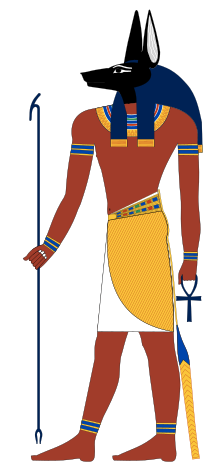Egypt Mythology : Anubis
Posted by Anubis ( /əˈnuːbəs/ or /əˈnjuːbəs/; Ancient Greek: Ἄνουβις) is the Greek name for a jackal-headed god associated with mummification and the afterlife in ancient Egyptian religion. He is the son of Nephthys and Set according to the Egyptian mythology. According to the Akkadian transcription in the Amarna letters, Anubis' name was vocalized in Egyptian as Anapa. The oldest known mention of Anubis is in the Old Kingdom pyramid texts, where he is associated with the burial of the pharaoh. At this time, Anubis was the most important god of the dead but he was replaced during the Middle Kingdom by Osiris.
Anubis ( /əˈnuːbəs/ or /əˈnjuːbəs/; Ancient Greek: Ἄνουβις) is the Greek name for a jackal-headed god associated with mummification and the afterlife in ancient Egyptian religion. He is the son of Nephthys and Set according to the Egyptian mythology. According to the Akkadian transcription in the Amarna letters, Anubis' name was vocalized in Egyptian as Anapa. The oldest known mention of Anubis is in the Old Kingdom pyramid texts, where he is associated with the burial of the pharaoh. At this time, Anubis was the most important god of the dead but he was replaced during the Middle Kingdom by Osiris.
He takes names in connection with his funerary role, such as He who is upon his mountain, which underscores his importance as a protector of the deceased and their tombs, and the title He who is in the place of embalming, associating him with the process of mummification. Like many ancient Egyptian deities, Anubis assumes different roles in various contexts.
Anubis also attends the weighing scale in the Afterlife during the "Weighing Of The Heart".
Anubis' wife is a goddess called Anput. His daughter is the goddess Kebechet.
Portrayal
Anubis was associated with the mummification and protection of the dead for their journey into the afterlife. He was usually portrayed as a half human, half jackal, or in full jackal form wearing a ribbon and holding a flail in the crook of its arm. The jackal was strongly associated with cemeteries in ancient Egypt, since it was a scavenger which threatened to uncover human bodies and eat their flesh. The distinctive black color of Anubis "did not have to do with the jackal [per se] but with the color of rotting flesh and with the black soil of the Nile valley, symbolizing rebirth."Anubis is depicted in funerary contexts where he is shown attending to the mummies of the deceased or sitting atop a tomb protecting it. In fact, during embalming, the "head embalmer" wore an Anubis costume. The critical weighing of the heart scene in the Book of the Dead also shows Anubis performing the measurement that determined the worthiness of the deceased to enter the realm of the dead (the underworld, known as Duat). New Kingdom tomb-seals also depict Anubis sitting atop the nine bows that symbolize his domination over the enemies of Egypt.
Embalmer
One of the roles of Anubis was "Guardian of the Scales". Deciding the weight of "truth" by weighing the Heart against Ma'at, who was often depicted as an ostrich feather, Anubis dictated the fate of souls. In this manner, he was a Lord of the Underworld, only usurped by Osiris.Anubis is a son of Ra in early myths, but later he became known as son of Osiris and Nephthys, and in this role he helped Isis mummify his dead father. Indeed, when the Myth of Osiris and Isis emerged, it was said that when Osiris had been killed by Set, Osiris' organs were given to Anubis as a gift. With this connection, Anubis became the patron god of embalmers: during the funerary rites of mummification, illustrations from the Book of the Dead often show a priest wearing the jackal mask supporting the upright mummy. Anubis' half-brother is Horus the Child, son of Osiris and Isis.
Perceptions outside Egypt
In later times, during the Ptolemaic period, Anubis was merged with the Greek god Hermes, becoming Hermanubis. The centre of this cult was in uten-ha/Sa-ka/ Cynopolis, a place whose Greek name simply means "city of dogs". In Book XI of "The Golden Ass" by Apuleius, we find evidence that the worship of this god was maintained in Rome at least up to the 2nd century. Indeed, Hermanubis also appears in the alchemical and hermetical literature of the Middle Ages and the Renaissance.Although the Greeks and Romans typically scorned Egypt's animal-headed gods as bizarre and primitive (Anubis was known to be mockingly called "Barker" by the Greeks), Anubis was sometimes associated with Sirius in the heavens, and Cerberus in Hades. In his dialogues (e.g. Republic 399e, 592a), Plato has Socrates utter, "by the dog" (kai me ton kuna), "by the dog of Egypt", "by the dog, the god of the Egyptians" (Gorgias, 482b), for emphasis. Anubis is also known as the god of mummification and death. Instead like other jackals Anubis' head was black to resemble the god of death.
Birth
Anubis was the son of Nephthys, and his father was Osiris. One myth says that Nephthys got Osiris drunk and the resultant seduction brought forth Anubis. Yet another says she disguised herself as Isis and seduced Osiris and subsequently gave birth to Anubis. Usually, Anubis is portrayed as the son of Nephthys and Set, Osiris' brother and the god of the desert and darkness.(from : http://en.wikipedia.org/wiki/Anubis)



